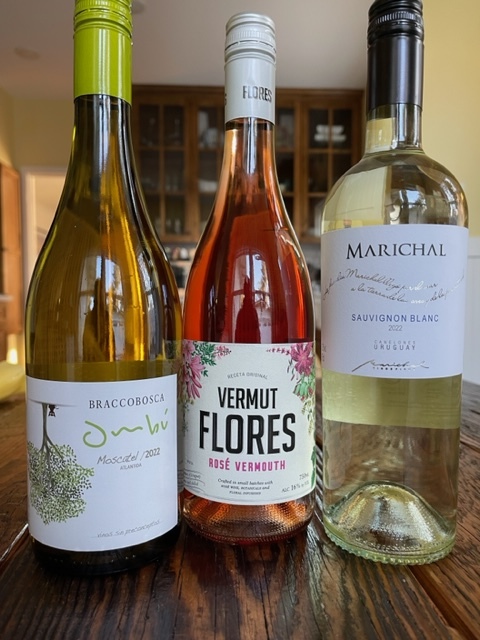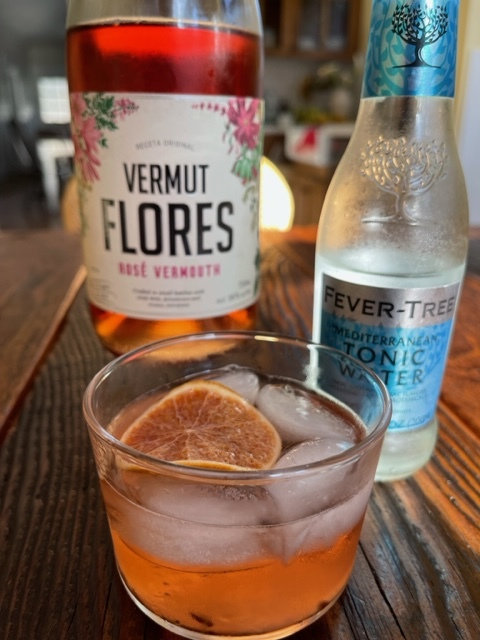The climate and the soils creates such balance between ripeness of fruit and acidity of the wines that is unique in South America
Joaquin Hidalgo, South American Editor at Vinous
The World Wine Travel group is exploring South America this year. This month we make virtual visit to Uruguay.
I had the good fortune to attending a remarkable webinar sponsored INAVI (The National Institute of Viticulture) and the Wines of Uruguay.

Disclosure: Wines provided in conjunction with the aforementioned webinar were provided as a media samples. No other compensation was involved. All opinions are mine.
About Uruguay
Like other Latin America countries, Uruguay’s wine industry can be traced back to colonial times and farms set up by Jesuits as mission for indigenous communities. It’s current day capital of Montevideo was founded between 1724 and 1730 as a Spanish fort to halt expansion of the Portuguese empire. Situated between its powerful neighbors Brazil and Argentina, Uruguay became a kind of neutral territory. That tag remains and underpins its progressive spirit to this day (hold on to this thought, I’ll come back to it)
Fueled by Basque and Italian immigration, the modern era began in the late 19th century. Its emblematic grape variety Tannat was brought to Uruguay from by Pascual Harriague in 1870.
During the aforementioned webinar, Daniel Pisano of Pisano Winery shard a story of how his Italian grandfather planted Italian grape varieties when he came to Uruguay. But, it didn’t take long for his grandfather to realize that his neighbors wines of Tannat were better than his. In that sense, Uruguay didn’t pick Tannat: Tannat picked Uruguay explained Mr. Pisano.
Fast forward to 20th century when, thanks to government incentives, most of the original Tannat vines were uprooted and replaced by French clones.
Remember that progressive spirit imbued in Uruguay’s culture I mentioned earlier?
Today, you’ll find that Uruguay is a bit of a paradox in South America. It is the second smallest country in South America, but it is 2nd in per capita GDP, has the highest literacy rate (98.7% even higher that the U.S.!), and the highest life expectancy in South America. It is the first country to deliver laptops to all students in grade school and high school.
Uruguay Wine At A Glance
- There are 14,800 acres/5991 ha under vine
- There are 180+ predominately family owned and operated wineries
- There are 6 distinct winegrowing regions – Northern Shore, Southern Shore, Metropolitan, Oceanic, Center and North, but almost 90% of Uruguay’s wine is grown in the Metropolitan departments of Canelones, San José and Montevideo.
- South America’s fourth largest wine producer
- Located between the 30 and 35 parallel (same as Mendoza, Argentina or Santiago Chile) Maritime influence influenced by proximity to Atlantic Ocean and calcareous soils rich in clay
- There are strong similarities between Uruguay and Bordeaux – both are influence by the Atlantic Ocean, both are planted in close proximity to estuaries and rivers and both are relatively humid and mild in climate.
- Combines best of European wine traditions with New World attitude and innovation and experimentation
- Tannat is the most planted grape, followed by Merlot and Cabernet Sauvignon. Sauvignon Blanc and Chardonnay are the most planted white grape varieties
In My Glass

2022 Bracco Bosca Moscatel Ombú – Uruguay, Coastal Region, Atlàntida
Pale lemon color with honeysuckle, jasmine grapefruit zest, Key lime, ripe peach and apricot aromas. On the palate, it’s between light and medium-bodied with vibrant acidity and ripe peach, Key lime, apricot, honey flavors complicated with an appealing hint of spice. 100% Moscatel. 13% abv|SRP – $16|88pts
This wine is first dry Moscatel to be produced in Uruguay! Fruit for this wine sourced from old-vine Moscatel planted on clay-calcareous soil
Vermuth Flores Rosé Vermouth
Tannat based Rosé Vermouth with 27 botanicals including 4 flowers(including roses, hops, elderflower and chamomile) The base wine is made at Marichal winery. 16% abv| SRP – $16.
This wine won a silver medal in its category at the 2021 International Wine Challenge. “Medium pink color redolent of a Chinese spice market with added floral notes. Syrup with complex spice and a marvelous play between bitterness and sweet” explains the tasting note from the competition.

I loved this Vermouth! It’s so refreshing on the rocks with tonic
2022 Bodega Marichal Sauvignon Blanc Premium Varietal – Uruguay, Canelones Pale lemon color with grapefruit, grass, asparagus, wet stone and gooseberry aromas. On the palate, it’s light-bodied with zesty acidity. It shows grapefruit, lime zest, gooseberry, lemongrass and just ripe white peach flavors with a wet stone minerality. 100% Sauvignon Blanc 12.5% abv|SRP – $14|87pts
Fruit for this wine sourced from two different vineyards planted on clay soils in the Canelones region and fermented in concrete

2019 Montes Toscanini Tannat Gran Tannat Premium – Uruguay, Las Piedras
Deep purple with black cherry, black currant leaf, roasted meat and cocoa nib On the palate it’s medium-bodied and very fresh with firm tannins and black currant, black cherry, plum, blackberry, espresso, dried herb, vanilla and a hint of dark chocolate flavors. Long finish. 14% abv|SRP – $59 (91 pts.)
Fruit sourced from the best parcels of their estate vineyards near the winery in Las Piedras within the Canelones Department . This wine is only produced in the best years. After fermentation the wine is held over winter in concrete tank, then aged 18 months in American oak.
2018 Alto de la Ballena Tannat/Viognier Reserva Sierra de la Ballena – Uruguay
Medium ruby color with black cherry, black currant, roasted peach, dried herb, dark chocolate and smoke aromas. On the palate it’s on the lighter end of medium-bodied with lively acidity and velvety tannins with black currant, black cherry, ripe blackberry, dark chocolate, vanilla and dried herb flavors. ABV – 14%|SRP – $24|(87 pts.)
Blend of 85% Tannat and 15% Viognier that was co-fermented. The vineyard is planted in limestone in the Sierra de la Ballena – Maldonado region. Aged in American oak for 9 months.
2019 Bodega Bouza Monte Vide Eu – Uruguay, Canelones, Las Violetas
Medium ruby color with black cherry, plum, blueberry, spice, vanilla, black tea, and cedar aromas. On the palate, it’s medium-bodied with lively acidity and velvety tannins with blackberry, blueberry, sour cherry, raspberry, vanilla, and dark chocolate flavors. 13.5% ABV| SRP – $67 (90 pts.)
Blend of 50% Tannat, 30% Merlot and 20% Tempranillo, each vinified separately and aged up to 16 months in American and French oak
2018 Pisano Tannat RPF (Reserva Personal de la Familia) – Uruguay, Progreso
Medium ruby color mulberry, black cherry, red currant, dark chocolate, ceda and a hint of smoke. On the palate it’s medium-bodied with good acidity and ripe tannins with mulberry, black cherry, red currant, vanilla and mocha flavors. 14% ABV|SRP – $24|89pts
100% Tannat planted on clay-calcareous soil in the Canelones department. Aged 10-12 months in French oak barrels
2020 Gimenez Mendez Tannat Alta Reserva – Uruguay, Canelones
Medium ruby color with black currant, plum, red licorice, violet, bramble, tobacco box and oak aromas. On the palate, it’s medium-bodied with lively acidity and firm tannins with black currant, black cherry, plum, vanilla and bittersweet chocolate flavors with a graphite minerality, and very satisfying finish. I recommend decanting for 60 minutes if time permits. 100% Tannat. 14% abv| SRP – $18|90 pts.)
Sourced from the family’s vineyards planted in 1995 on clay, loam soil in Las Brujas in the Canelones department. Raised for 9 months in French oak barrels.
2020 Bodegones del Sur Cabernet Franc Vineyard Select Juanicó – Uruguay, Canelones, Juanicó
Pale ruby color with red cherry, red currant, raspberries, crushed rock, dried herb and a hint of roasted bell pepper aromas. On the palate, it’s medium-bodied with juicy acidity and velvety tannins and mixed black and red cherry, red currant, raspberry flavors with an appealing bit of herbaceous savoriness. 100% Cabernet Franc raised in 30% of American and French oak barrels.13.5% abv|SRP – $20|89 pts.)
Fruit for this wine sourced vineyard planted on vertical schist in the Sierra de Mahoma region in the San Jose department.
My Takeaways
I was very impressed with the wines I tried. Of course, Tannat dominated samples, and the grape has a reputation for being a tannic monster. But, be it a “classic” or more New World style Tannat, I found the tannins to be well managed in all the wines. And with the bottle of Cabernet Franc, the dry Moscatel and the Vermut, I was able to get a sense of New World attitude and innovation and experimentation happening with Uruguayan wines.
All the wines I samples are available in the United States. I highly recommend you seek out the wines and I think you’ll discover the same thing I did….Exciting things are happening in small, but mighty Uruguay!
In invite you to read what my fellow World Wine Travel writers discovered. I bet you’ll find a recipe for Uruguayan cuisine to pair with the wines of Uruguay.
What a great webinar! We tasted a few of these on our Uruguay, but not that Vermut
Thanks Lynn. I thought the Vermouth was 🔥🔥🔥. In tend to purchase more!
Cool for you, super that you have access to it!
How lucky you were to recieve so many wonderful wines to taste. How would that vermouth work in a Manhattan?
Uruguay was high on our list to visit before we got into wine but now even more so because of what we’re hearing about in that department!
It seems that oeno-tourism is becoming a big thing in Uruguay. I bet it’s a great time to visit!